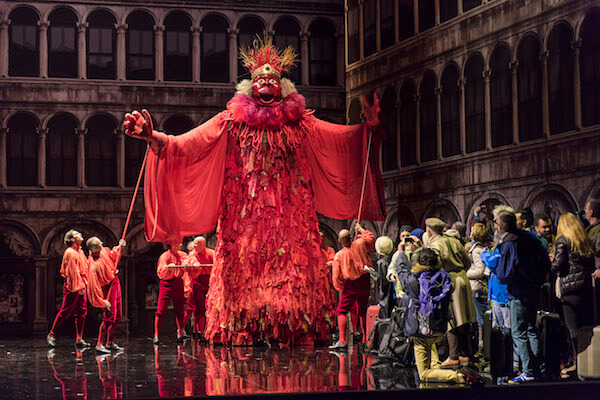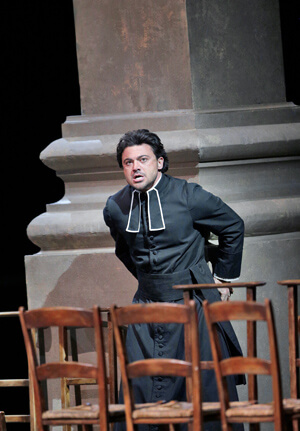In the first decade of James Levine’s artistic era at the Metropolitan Opera, two directors emerged who dominated the Italian and German wings with a traditional production style. The Italian director-designer Franco Zeffirelli created a series of visually spectacular Puccini productions in the 1980s that wowed audiences, though critics demurred. The Austrian actor-director Otto Schenk’s neoromantic 1977 production of Wagner’s “Tannhäuser” established him (in collaboration with scenic designer Günther Schneider-Siemssen who died this past June) as the go-to director for Wagner at the Met, culminating in the “Ring” cycle.
Peter Gelb has systematically replaced these traditional productions with decidedly mixed success. Gelb has vowed to preserve Zeffirelli’s “Turandot” and “La Bohème” (both are revived this season), but this season’s revival of “Tannhäuser” may be our last look at Schenk’s lovely old production.
The Zeffirelli “Turandot” returned on September 23 with the three lead singers making house role debuts. Dramatic soprano Christine Goerke’s attempt at the titular anti-heroine proved a mixed bag. Her darkly expansive middle and lower registers are topped by a narrower but penetrating upper register. The role of Turandot centers on the upper third of the soprano range, requiring a laser-like tone that expands on high. For Goerke, it was an uneasy fit. The opening aria “In Questa Reggia” was marred by out-of-tune attacks and tentative high notes, but the three riddles were powerfully projected.
Met revives Zeffirelli’s production of “Turandot,” Schenk’s “Tannhäuser”
In Act III, Goerke’s tone took on a more womanly coloration. Goerke’s variety of tonal color enlivened many phrases, and her acting was authoritative with a telling economy of gesture and movement.
Marcelo Alvarez as Calaf sounded covered in Act I, with a tendency to puff up the tone at the expense of real legato. In Act II, his warm latin tenor gained a modicum of ping and projection, and he phrased more like a big scale lyric tenor with better results. He was intermittently engaged in the action, with a rather casual stage manner.
Hibla Gerzmava’s Liù, conversely, was rather formal and reserved in demeanor but unleashed a lush full lyric soprano that had lift and float. She was ambitious, with dynamic effects shading from loud to soft and vice versa — mostly with success. James Morris had a good night as Timur with some of the old juice restored to the tone.
Paolo Carignani’s tempos seemed rather arbitrary, with many of the Act I choral sections taken faster or slower than usual; the more singer-driven later acts cohered better.
Zeffirelli’s production looked as fresh as ever after 30 years, with the audience again gasping at the reveal of the glittering Act II throne room set.
Schenk’s production of “Tannhäuser” returned in October after more than a decade’s absence, with the original conductor James Levine in the pit. The production, though certain elements look dated, has held up better than the conductor. Earlier in the week Levine had announced he was withdrawing from the new production of Berg’s “Lulu” to concentrate on “Tannhäuser” — this during the season that was to mark his comeback as full-time music director of the company. Conducting from a motorized wheelchair, Levine seemed to have less mobility in his upper body, with spasmodic slashing motions of his arms.
The pilgrim’s theme during the overture unfurled in slow motion, almost grinding to a halt, and the Act I finale was barely held together. In Act II, the introduction to “Dich, teure halle” revealed a return of the vivacious old Jimmy, and he seemed to gain energy and control through to the end of the long evening.
Johan Botha has drawn criticism for his bulky and immobile facial and physical acting (by this critic, especially for an Otello compromised by vocal indisposition). His vocal virtues cannot be denied, and his account of the title role was impressive. Tannhäuser is written awkwardly for the heroic tenor voice, requiring stamina in the fragile upper middle break where the tone wants to contract rather than expand. Botha maintained a clear bell-like tone all night, despite the occasional squeezed nasal shout. He sang rather than declaimed the lengthy Act III Rome narration with textual point and coloration. Botha’s acting was not without detail and his experience in the role showed.
Peter Mattei’s Wolfram also evoked golden age comparisons with a heady lyric tone, aristocratic phrasing, and deeply empathetic acting. He seemed the conscience of the opera — a passive witness who becomes our viewpoint for the story’s conflicting issues. As Landgraf Hermann, young German bass Günther Gröissbock had his best Met outing so far — the tone firm and focused with an impressive stage presence.
The male leads were cast from strength but the two ladies representing the opposing poles of fleshly and spiritual love reflected the ravages of long service in the Wagner wars. Michelle de Young returned as Venus with her warm tone compromised by prominent vibrato and squally top notes, and her acting was by the numbers vamp. Eva-Maria Westbroek’s committed acting made Elisabeth a real woman and not a symbol. Her emotional generosity and feminine grandeur evoked the production’s first Elisabeth — the legendary Leonie Rysanek. Sadly, Westbroek’s tone also was marred by widening vibrato under pressure and edgy high notes, but her phrasing was beautiful. On October 15, her voice settled down and the top was better controlled. Ying Fang as the Shepherd Boy sang with jewel-like purity of tone.
Schneider-Siemssen’s sets for “Tannhäuser” evoke the landscape paintings of Caspar David Friedrich. The colors have faded slightly, giving them an antiqued old master quality but the Act I transition from the Venusberg to the deserted plain and the high domed Hall of Song set in Act II are still impressive.
“Tannhäuser” will be transmitted in HD on October 31 at 11:55 a.m. for those who can’t see it in the house.




































